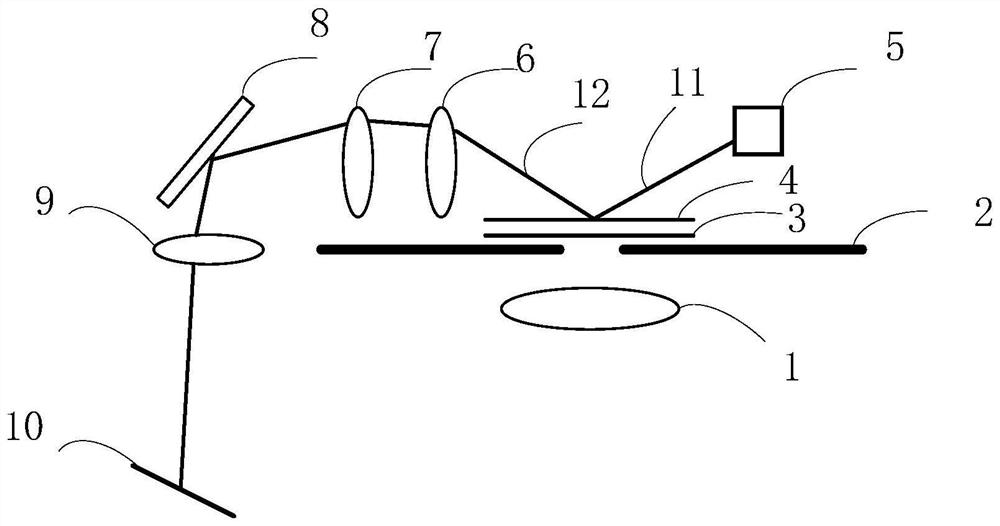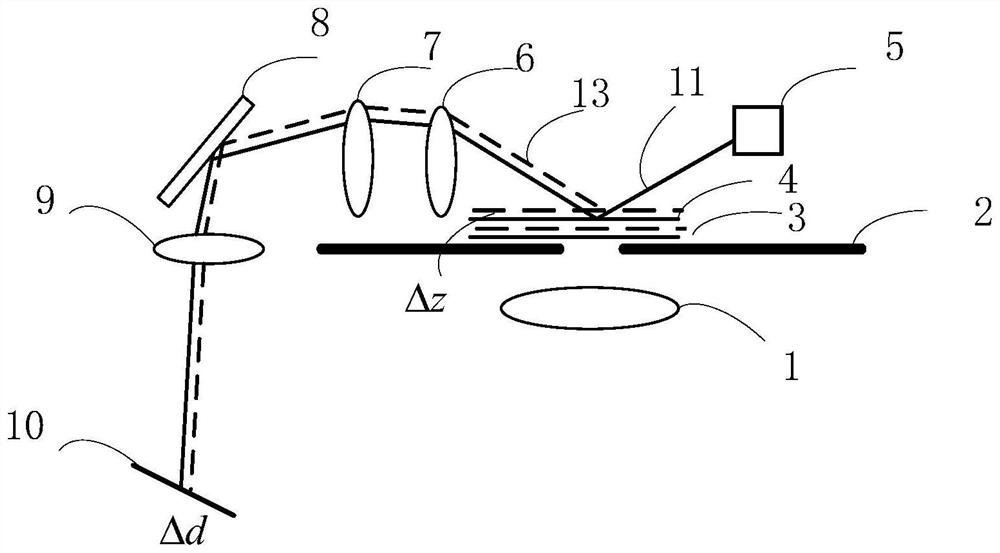Microimaging focus locking system and method and microscope
A micro-imaging and focus-locking technology, applied in the field of microscopes, can solve the problems of high optical path coaxiality, poor coaxiality, and increased difficulty in system installation and adjustment, so as to simplify the mechanism, reduce the difficulty of processing and adjustment, The effect of a small number of components
- Summary
- Abstract
- Description
- Claims
- Application Information
AI Technical Summary
Problems solved by technology
Method used
Image
Examples
Embodiment 1
[0024] like figure 1 As shown, the present invention discloses a microscopic imaging focus locking system, comprising a light source 5, a first lens 6, a second lens 7, a third lens 9, a detector 10 and an objective lens displacement controller; the light source 5 is used for To generate incident light, the first lens 6, the second lens 7 and the third lens 9 are sequentially arranged on the propagation path of the reflected light beam 12, and the reflected light beam 12 is formed by the incident light beam 11 reflected by the upper surface 4 of the glass slide; The first lens 6 and the second lens 7 form a beam expander group, the beam expander group is used to amplify the offset, and the third lens 9 is used to converge the reflected light beam 12 to a beam set at a first angle. Detector 10, the detector 10 is used to compare the first position of the first spot formed by the reflected light beam 12 with the initial position of the pre-stored initial spot, and send the first...
Embodiment 2
[0041] The invention also discloses a microscopic imaging focus locking method, comprising:
[0042] Correct the focus-locking system to obtain the initial position of the initial spot. The focus-locking system includes: a light source 5, a first lens 6, a second lens 7, a third lens 9, a detector 10 and an objective lens displacement controller; the light source The incident light emitted by 5 is reflected by the upper surface 4 of the glass slide to form a reflected light. The reflected light passes through the first lens 6, the second lens 7 and the third lens 9 in sequence and then converges on the detector 10 to form an initial spot and record the initial spot of the initial spot. position; the first lens 6 and the second lens 7 form a beam expander group, the beam expander group is used to amplify the offset, and the third lens 9 is used to converge the reflected beam 12 to a first angle set detector 10;
[0043] When the slide is displaced in the vertical direction, th...
Embodiment 3
[0050] The present invention also discloses a microscope, which applies the focus locking system described in Embodiment 1.
[0051] In this embodiment, the microscope may be an inverted fluorescence microscope. The focus locking system of the present invention can be matched with various types of microscopes, and is not limited to a certain microscope.
[0052] To sum up, the embodiments of the present invention provide a microscopic imaging focus locking system, method and microscope, the beneficial effects are: the focus locking system of the present invention in which the incident light does not enter the objective lens 1, when the focus is locked, the microscopic imaging system is affected. Dependence and influence can be ignored; the focus locking system has fewer components and a simplified mechanism, which reduces the difficulty of processing and assembling, and is a modular system that is easier to implement; the focus locking system of the present invention is compat...
PUM
 Login to View More
Login to View More Abstract
Description
Claims
Application Information
 Login to View More
Login to View More - R&D
- Intellectual Property
- Life Sciences
- Materials
- Tech Scout
- Unparalleled Data Quality
- Higher Quality Content
- 60% Fewer Hallucinations
Browse by: Latest US Patents, China's latest patents, Technical Efficacy Thesaurus, Application Domain, Technology Topic, Popular Technical Reports.
© 2025 PatSnap. All rights reserved.Legal|Privacy policy|Modern Slavery Act Transparency Statement|Sitemap|About US| Contact US: help@patsnap.com



